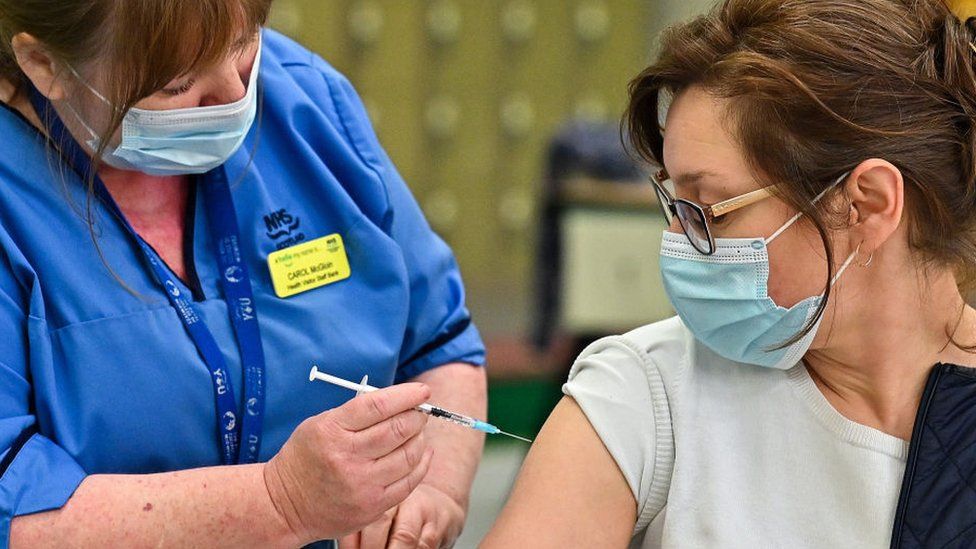
By Lisa Summers
Scotland Health Correspondent
The nights are drawing in, the schools are going back and a new Covid variant is circulating. It all sounds very familiar.
But we are a long way from the autumn of 2020 when the coronavirus dominated our lives and there were different “levels” of lockdown across Scotland.
So as we head into this autumn what should we expect?
Firstly, the new variant. It’s called EG.5 and is an offshoot of Omicron. The World Health Organization currently classifies it as a variant of interest.
The MRC-University of Glasgow Centre for Virus Research has played a key role in monitoring new variants of the disease throughout the pandemic.
Prof Massimo Palmarini says he is not too worried about what he is seeing
Prof Massimo Palmarini, who heads the centre, says he is not too worried about what he is seeing but it is important that surveillance continues.
“The new variant doesn’t seem to have dramatic differences from the previous one but it doesn’t mean that it is not important,” he says.
He says there is a concern that if surveillance is cut back too much it will be hard to predict which variants might emerge and which ones will be more worrying than others.
According to Scotland’s national public health body the pandemic is now in a “quieter phase”.
That means that from the end of this month, testing will be scaled back.
There is to be no more routine testing in hospitals, prisons or care homes.
Instead if you have symptoms you will be tested in the same way as other infectious diseases are monitored.
Meanwhile, new advice from the Joint Committee on Vaccination and Immunisation (JCVI) means that the Covid vaccine booster programme is also being scaled back.
This year it will be offered to people aged 65 and over, as well younger people with underlying health conditions and in groups such as health and social care workers or people who live with those who are immunocompromised.
How much Covid is there?
Getting accurate data on Covid cases is much harder now.
The weekly figures from Public Health Scotland only measure the number of patients in hospital with Covid.
But this data does not tell us how much Covid is circulating in the community.
Dr Antonia Ho says we need a more complete picture in order to identify potential new variants
That worries Dr Antonia Ho, an infectious diseases consultant and senior clinical lecturer at the MRC – Centre for Virus Research.
She says: “We don’t really have a good sense of what’s happening in the community because we don’t have much in the way of community surveillance and largely testing isn’t happening anymore.
“That is a worry from a research point of view in terms of being able to look out for potentially more threatening variants.
“We are not sequencing anywhere near as much as we were and obviously the more information you have, the better.
“And we do need a more complete picture in order to identify potential new variants that might cause problems for us.”
Should we treat Covid in the same way as flu?
The good news, Dr Ho says, is that because most of the population have hybrid immunity either from vaccination or natural infection then the majority of cases are milder.
But she says some people continue to experience complications.
There has also been a lot of discussion about considering Covid as a virus that we live with in the same way as flu.
Dr Ho is a little wary of that.
She says: “In terms of symptoms, they are pretty similar.
“It is quite hard to differentiate as a clinician, someone who presents to hospital with flu and someone who presents with Covid.
“But there are some important differences.
“People with flu are more prone to bad secondary bacterial infections, whereas for Covid, we see a lot more clots like lung and heart clots for example, and long Covid is an important complication.
“For example, a recent study in Australia found that in a very highly-vaccinated population infected with Omicron that one in five people described long Covid symptoms. So, long Covid is an important consideration.”
Apathy warning
The main warning as we head into winter is not to be too complacent.
Vaccine uptake during the spring booster campaign for over 75s dropped significantly.
And last autumn only about 50% of health and social are workers came forward for a jag.
Dr Ho says getting protected is the best form of defence with the NHS facing another really difficult winter.
“Last winter, we experienced major pressure from RSV (Respiratory syncytial virus), flu and Covid and I would anticipate much of the same,” she says.
“We often look to Australia’s experience and they’ve had another busy flu season.
“This year they’ve seen a lot of influenza B which tends to target children a bit more and 80% of their admissions have been in children so we might see a real pressure on paediatric services for example.
“So in an already pressured NHS if we see another big wave with three respiratory viruses that can drive a lot of admissions, albeit they might not be as severe as we saw in the first couple of waves, it may still cause a lot of problems for the NHS.”








